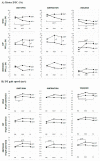Structured Cognitive-Motor Dual Task Training Compared to Single Mobility Training in Persons with Multiple Sclerosis, a Multicenter RCT
- PMID: 31835502
- PMCID: PMC6947084
- DOI: 10.3390/jcm8122177
Structured Cognitive-Motor Dual Task Training Compared to Single Mobility Training in Persons with Multiple Sclerosis, a Multicenter RCT
Abstract
The aim was to compare the effectiveness of dual-task training (DTT) compared to single mobility training (SMT) on dual-task walking, mobility and cognition, in persons with Multiple Sclerosis (pwMS). Forty pwMS were randomly assigned to the DTT or SMT groups. The DTT-group performed dual-task exercises using an interactive tablet-based application, while the SMT-group received conventional walking and balance exercises. Both interventions were supervised and identical in weeks (8) and sessions (20). Nine cognitive-motor dual-task conditions were assessed at baseline, after intervention and at 4-weeks follow-up (FU). The dual-task cost (DTC), percentage change of dual-task performance compared to single-task performance, was the primary outcome. Mobility and cognition were secondarily assessed. Mixed model analyses were done with group, time and the interaction between group and time as fixed factors and participants as random factors. Significant time by group interactions were found for the digit-span walk and subtraction walk dual-task conditions, with a reduction in DTC (gait speed) for the DTT maintained at FU. Further, absolute dual-task gait speed during walking over obstacles only improved after the DTT. Significant improvements were found for both groups in various motor and cognitive measures. However, the DTT led to better dual-task walking compared to the SMT.
Keywords: balance; cognition; cognitive motor interference; dual task; gait; multiple sclerosis.
Conflict of interest statement
The authors declare no conflict of interest. The funders had no role in the design of the study; in the collection, analyses, or interpretation of data; in the writing of the manuscript, or in the decision to publish the results.
Figures


References
Grants and funding
LinkOut - more resources
Full Text Sources
Medical

